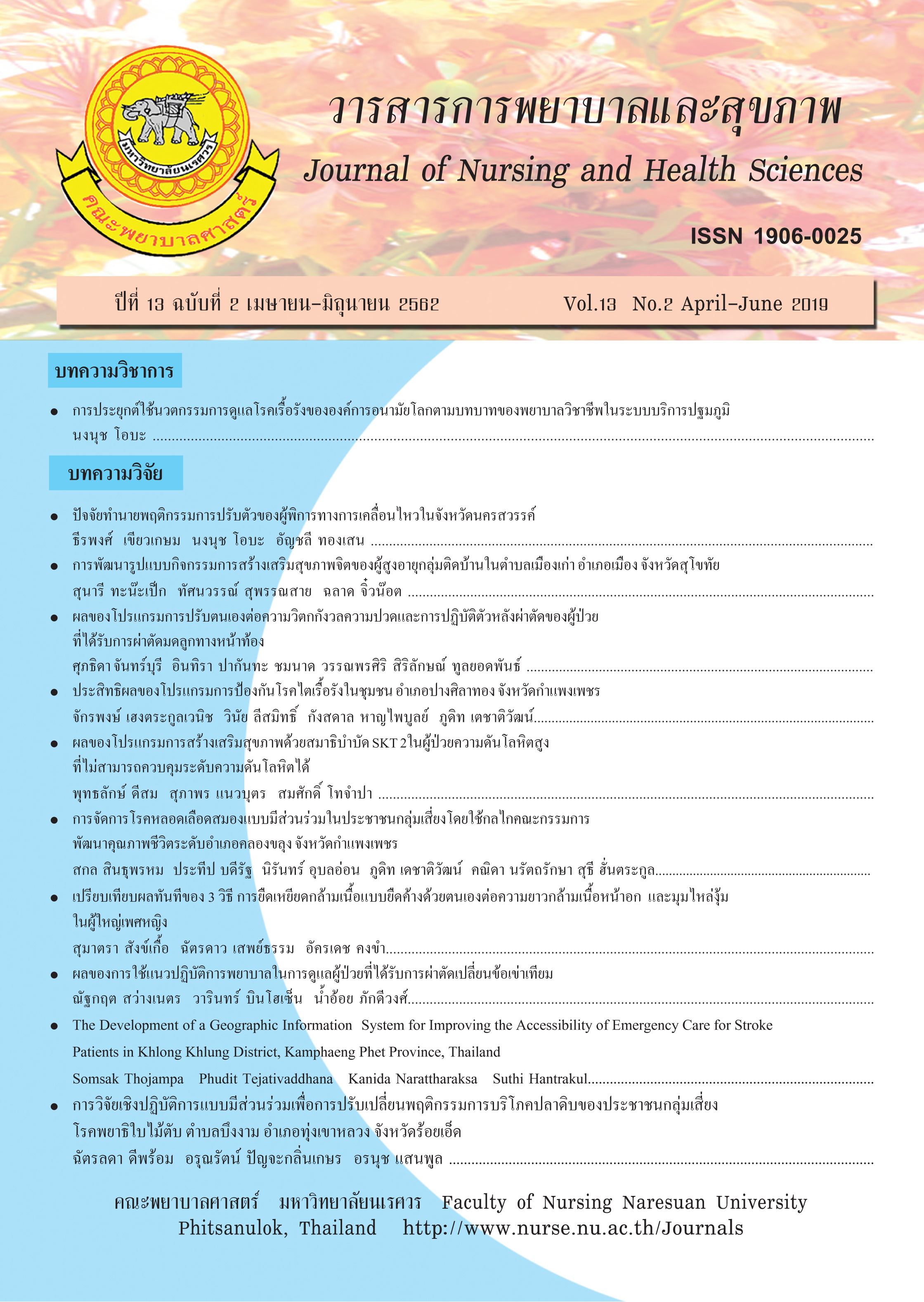Effects of Self-regulation Program on Anxiety, Pain, and Postoperative Practice among Patients with Abdominal Hysterectomy
Main Article Content
Abstract
The objective of this quasi-experimental research was to study the effects of a Self-regulation Program on the anxiety, pain, and postoperative practice among patients with abdominal hysterectomy. The sample was composed of patients who were admitted to the Naresuan University Hospital, Phitsanulok, Thailand. A total of 46 patients were recruited, 23 patients were assigned in the control group who received routine nursing care, and 23 patients were assigned in the experimental group who received the Self-regulation Program based on the Self-regulation theory of Leventhal and Johnson (1983). The instruments consisted of 1) personal record,2) anxiety assessment form, 3) pain assessment form and 4)postoperative practice assessment form. Data were analyzed by using Chi-square test,Mann-Whitney Utest, paired t-test, independent t-test, and Two-way Repeated measures ANOVA The findings showed as follows: 1) After receiving the self-regulation program, the mean score of anxiety in the experimental group was lower than before the program with a statistical significance level of .001. 2) The mean score of anxiety in the experimental group was lower than that in the control group with a statistical significance level of .001. 3) The mean score of pain after abdominal hysterectomy at 48, and 72 hours in the experimental group was lower than that in the control group with a statistical significance level of .01. However, at 24 hours after operation, the mean scores of pain of both groups were not significantly different (p > .05). 4) The mean score of postoperative abdominal hysterectomy practice at 48 hours and 72 hours in the experimental group was higher than that in the control group with a statistical significance level of .05.
Article Details
References
Anotharom, J. (2007). The role of nurses in preventing
pain from surgery.Journal of Nursing Science,
(1), 14-23.
Ardharn, L. (2002). Effect of preparatory information
on anxiety in abdominal surgical patients.
Master Thesis (Nursing), Khon Kaen University,
Khon Kaen. [In Thai].
Beare, P. G., & Myers, J. L. (1998).Adult health nursing
(3rded.). St.Louis: Mosby.
Bonica, J. J. (1990). The management of pain (2nded.).
London: Lea and Febiger.
Chinnoros, S., Jirapinyo, M.,& Punpho, K. (2009).
Pain management and satisfaction with
pain management in patients undergoing total
abdominal hysterectomy.Ramathibodi Nursing
Journal, 15(3), 327-343.[In Thai].
Craven, R. F., & Hirnle, C. J. (2009).Fundamentals of
nursing: Human health and function (6thed).
Philadelphia: Wolters Kluwer, Lippincott and
Williams and Wilkins.
Elliott, A. C.,& Woodward, W. A. (2007).Statistical
analysis quick reference guidebook with
spss examples.Thousand Oaks, CA: SAGE
Publications, Inc.
Good, M., Stanton-Hicks, M., Grass, J. A., Anderson, G.
C., Makii, M.,& Geras, J. (2000). Pain after
gynecologic surgery.Pain Management Nursing,
(3), 96-104.
Gercek, E., Dal, N.A., Dag, H.,& Senveli, S. (2016).
The information requirements and self-perceptions
of Turkish women undergoing hysterectomy.
Pakistan Journal of Medical Sciences,32(1),
-170.
Horalith. (2008). Effectiveness of preparatory information
on anxiety in patients with gastrointestinal surgery.
Master Thesis (Nursing), Khon Kaen University,
Khon Kaen. [In Thai].
Innok, J. (2008). The effects of preparatory information
on pain and distress in patients undergoing
abdominal surgery.Master Thesis (Nursing),
Mahasarakham University, Mahasarakham.
[In Thai].
Johnson, J. E.,& Lauver, D. R. (1989).Altertnative
explanations of coping with stressful experience
associated with physical illness. Advances in
Nursing Science, 11(2), 39-52.
Kneisl, C. R. (1998). Stress, anxiety and coping.In H. S.
Wilson & C. R. Kneisl (Ed.), Psychiatric nursing
(3 rded.)(pp. 123-147). Califonia: Addison Wesley
Publishing.
Kumar, S. (2015).The effect of preoperative anxiety on
post operative pain.Indian Journal of Health and
Wellbeing, 6(6), 622-624.
Leventhal, H.,& Johnson, J. E. (1983).Laboratory and
field experimentation: Development of a theory
of self-regulation. In P.J. Wooldridge, M.
H.Schmitt, J. K. Skipper, and R. C. Leonard (Ed.),
Behavioral science and nursing theory (pp.
-262). St. Louis: The C.V. Mosby Company.
Mittison, S. (2002).The Effects of preparatory on anxiety
and postoperative performance in patients
undergoing surgery for renal and ureteric
calcul.Master Thesis (Nursing), Khon Kaen
University, Khon Kaen. [In Thai].
Padma, P. S., Roach, E. J.,& Lobo, D. J. (2017).
Effectiveness of preoperative instructions.
Manipal Journal of Nursing and Health Sciences,
(1), 3-9.
Pakanta, I., & Prachanban, P. (2015).Linear structural
relationship model of the patients’s distress
during extracorporeal shock wave lithotripsy
(ESWL). Journal of Nursing and Health Sciences,
(1), 47-58.[In Thai].
Polit, D. F.,& Beck, C. T. (2004).Nursing research:
Principles and methods (7thed.). Philadelphia:
Wolters kluwer health/Lippincott williams and
wilkins.
Puntillo, K. A. (1988). The phenomenon of pain and critical
care nursing.Heart and lung, 17(3), 262-273.
Rittithrum, W.,&Chinnoros, S.(2012). The result of
preparatory information on anxiety and pain in
abdominal surgery patients.Kuakarun Journal of
Nursing,19(2), 75-87.[In Thai].
Senadisai, S.& Prapaipanich, W. (2015).Fundamental
nursing.Bangkok: Golden Point Co.,Ltd.[In Thai].
Smeltzer, S. C., Bare, B. G., Hinkle, J. L.,& Cheever,
K. H. (2010). Brunner and Suddarth’stextbook
of medical-surgical nursing (12thed.). New York:
Lippincott Williams and Wilkins.
The Obstetrics and Gynecology wards in Naresuan
University Hospital. (2016). The statistical
reportsof patientswereadmitted to obstetrics and
gynecology wards inNaresuan University
Hospital, Phitsanulok in 2015 and 2016.
Phitsanulok: Naresuan University Hospital.
[In Thai].
Thongmee, S. (2005).Factors influencing preoperative
anxiety of patients who received preoperative
treatment in Sappasitthiprasong Hospital.
Master Thesis (Nursing), Ratchathani University,
Ubon Ratchathani. [In Thai].
Vajiratanakorn, S.,& Chulnoul, P. (2017). Information
needs and received in preoperative patients for
gynecologic surgery. The Journal of Faculty
of Nursing Burapha University, 25(4), 51-59.
[In Thai].
Vorapongsathorn, T. (2000).Principles of public health
research(4th ed.). Bangkok: Chulalongkorn
University Printing House.[In Thai].
Williamson, M. L. (1992). Sexual adjustment after
hysterectomy.Journal of Obstetric Gynecology
and Neonatal Nursing, 21(1), 42-47.


